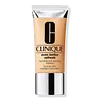Clinique Even Better Refresh Hydrating and Repairing Makeup Versus Mob Beauty Blurring Ceramide Cream Foundation
What's inside
What's inside
 Key Ingredients
Key Ingredients

 Benefits
Benefits

 Concerns
Concerns

 Ingredients Side-by-side
Ingredients Side-by-side

Water
Skin ConditioningDimethicone
EmollientMethyl Trimethicone
Skin ConditioningTrimethylsiloxysilicate/Dimethiconol Crosspolymer
Butylene Glycol
HumectantPhenyl Trimethicone
Skin ConditioningNeopentyl Glycol Diheptanoate
EmollientNiacinamide
SmoothingHydroxyethyl Urea
HumectantPPG-12/Smdi Copolymer
EmollientLauryl PEG-9 Polydimethylsiloxyethyl Dimethicone
Skin ConditioningGlycerin
HumectantSodium Polyaspartate
HumectantPEG-10 Dimethicone
Skin ConditioningSigesbeckia Orientalis Extract
Skin ConditioningPolygonum Cuspidatum Root Extract
AntioxidantAcetyl Hexapeptide-8
HumectantSorbitol
HumectantIsopropyl Isostearate
EmollientPPG-15 Stearyl Ether
EmollientMicrococcus Lysate
Skin ConditioningResveratrol
AntioxidantPalmitoyl Hexapeptide-12
Skin ConditioningSalicylic Acid
MaskingCaffeine
Skin ConditioningPolysilicone-11
Sodium Chloride
MaskingTocopheryl Acetate
AntioxidantPolymethyl Methacrylate
Disteardimonium Hectorite
StabilisingDimethicone/PEG-10/15 Crosspolymer
Lecithin
EmollientTriethoxycaprylylsilane
Caprylyl Glycol
EmollientZinc Stearate
Cosmetic ColorantGlyceryl Polymethacrylate
Laureth-7
EmulsifyingTrehalose
HumectantTriethyl Citrate
MaskingSodium Hyaluronate
HumectantDimethicone Silylate
PEG-8
HumectantMagnesium Aluminum Silicate
AbsorbentMethicone
EmollientAlumina
AbrasiveSilica
AbrasivePropylene Glycol Caprylate
Skin ConditioningHexylene Glycol
EmulsifyingXanthan Gum
EmulsifyingDisodium EDTA
BHT
AntioxidantPotassium Sorbate
PreservativePhenoxyethanol
PreservativeMica
Cosmetic ColorantCI 77491
Cosmetic ColorantCI 77492
Cosmetic ColorantCI 77499
Cosmetic ColorantCI 77891
Cosmetic ColorantWater, Dimethicone, Methyl Trimethicone, Trimethylsiloxysilicate/Dimethiconol Crosspolymer, Butylene Glycol, Phenyl Trimethicone, Neopentyl Glycol Diheptanoate, Niacinamide, Hydroxyethyl Urea, PPG-12/Smdi Copolymer, Lauryl PEG-9 Polydimethylsiloxyethyl Dimethicone, Glycerin, Sodium Polyaspartate, PEG-10 Dimethicone, Sigesbeckia Orientalis Extract, Polygonum Cuspidatum Root Extract, Acetyl Hexapeptide-8, Sorbitol, Isopropyl Isostearate, PPG-15 Stearyl Ether, Micrococcus Lysate, Resveratrol, Palmitoyl Hexapeptide-12, Salicylic Acid, Caffeine, Polysilicone-11, Sodium Chloride, Tocopheryl Acetate, Polymethyl Methacrylate, Disteardimonium Hectorite, Dimethicone/PEG-10/15 Crosspolymer, Lecithin, Triethoxycaprylylsilane, Caprylyl Glycol, Zinc Stearate, Glyceryl Polymethacrylate, Laureth-7, Trehalose, Triethyl Citrate, Sodium Hyaluronate, Dimethicone Silylate, PEG-8, Magnesium Aluminum Silicate, Methicone, Alumina, Silica, Propylene Glycol Caprylate, Hexylene Glycol, Xanthan Gum, Disodium EDTA, BHT, Potassium Sorbate, Phenoxyethanol, Mica, CI 77491, CI 77492, CI 77499, CI 77891
Octyldodecanol
EmollientCetearyl Nonanoate
EmollientTridecyl Trimellitate
EmollientSilica
AbrasivePhytosteryl/Octyldodecyl Lauroyl Glutamate
Skin ConditioningCandelilla Cera
EmollientDextrin Isostearate
Skin ConditioningMica
Cosmetic ColorantCeramide Ns
Skin ConditioningCopernicia Cerifera Cera
EmollientSodium Hyaluronate
HumectantCoco-Caprylate/Caprate
EmollientTriheptanoin
Skin ConditioningPersea Gratissima Oil
Skin ConditioningDisteardimonium Hectorite
StabilisingPropylene Carbonate
SolventTriisostearyl Citrate
EmollientC9-12 Alkane
SolventDilinoleic Acid/Butanediol Copolymer
Castor Oil/Ipdi Copolymer
Ricinus Communis Seed Oil
MaskingHydrogenated Castor Oil
EmollientDehydroacetic Acid
PreservativePhytosphingosine
Skin ConditioningTetrahexyldecyl Ascorbate
AntioxidantTocopherol
AntioxidantBisabolol
MaskingStearoyl Glutamic Acid
CleansingHydrogenated Vegetable Oil
EmollientCI 77891
Cosmetic ColorantIron Oxides
CI 77288
Cosmetic ColorantOctyldodecanol, Cetearyl Nonanoate, Tridecyl Trimellitate, Silica, Phytosteryl/Octyldodecyl Lauroyl Glutamate, Candelilla Cera, Dextrin Isostearate, Mica, Ceramide Ns, Copernicia Cerifera Cera, Sodium Hyaluronate, Coco-Caprylate/Caprate, Triheptanoin, Persea Gratissima Oil, Disteardimonium Hectorite, Propylene Carbonate, Triisostearyl Citrate, C9-12 Alkane, Dilinoleic Acid/Butanediol Copolymer, Castor Oil/Ipdi Copolymer, Ricinus Communis Seed Oil, Hydrogenated Castor Oil, Dehydroacetic Acid, Phytosphingosine, Tetrahexyldecyl Ascorbate, Tocopherol, Bisabolol, Stearoyl Glutamic Acid, Hydrogenated Vegetable Oil, CI 77891, Iron Oxides, CI 77288
Alternatives
Ingredients Explained
These ingredients are found in both products.
Ingredients higher up in an ingredient list are typically present in a larger amount.
Ci 77891 is a white pigment from Titanium dioxide. It is naturally found in minerals such as rutile and ilmenite.
It's main function is to add a white color to cosmetics. It can also be mixed with other colors to create different shades.
Ci 77891 is commonly found in sunscreens due to its ability to block UV rays.
Learn more about CI 77891Disteardimonium Hectorite comes from the clay mineral named hectorite. It is used to add thickness to a product.
It can also help stabilize a product by helping to disperse other ingredients.
Hectorite is a rare, white clay mineral.
Learn more about Disteardimonium HectoriteMica is a naturally occurring mineral used to add shimmer and color in cosmetics. It can also help improve the texture of a product or give it an opaque, white/silver color.
Serecite is the name for very fine but ragged grains of mica.
This ingredient is often coated with metal oxides like titanium dioxide. Trace amounts of heavy metals may be found in mica, but these metals are not harmful in our personal products.
Mica has been used since prehistoric times throughout the world. Ancient Egyptian, Indian, Greek, Roman, Aztec, and Chinese civilizations have used mica.
Learn more about MicaSilica, also known as silicon dioxide, is a naturally occurring mineral. It is used as a fine, spherical, and porous powder in cosmetics.
Though it has exfoliant properties, the function of silica varies depending on the product.
The unique structure of silica enhances the spreadability and adds smoothness, making it a great texture enhancer.
It is also used as an active carrier, emulsifier, and mattifier due to its ability to absorb excess oil.
In some products, tiny microneedles called spicules are made from silica or hydrolyzed sponge. When you rub them in, they lightly polish away dead skin layers and enhance the penetration of active ingredients.
Learn more about SilicaSodium Hyaluronate is hyaluronic acid's salt form. It is commonly derived from the sodium salt of hyaluronic acid.
Like hyaluronic acid, it is great at holding water and acts as a humectant. This makes it a great skin hydrating ingredient.
Sodium Hyaluronate is naturally occurring in our bodies and is mostly found in eye fluid and joints.
These are some other common types of Hyaluronic Acid:
Learn more about Sodium Hyaluronate